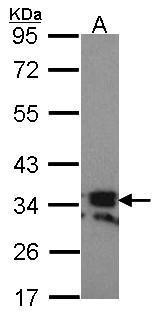RANKL (TNFSF11) Rabbit Polyclonal Antibody
CAT#: TA308970
Rabbit Polyclonal antibody to RANKL (tumor necrosis factor (ligand) superfamily, member 11)
USD 200.00
USD 867.00
USD 436.00
Specifications
| Product Data | |
| Applications | IHC, WB |
| Recommended Dilution | IHC:1:100-1:1000; WB:1:500-1:3000 |
| Reactivities | Human (Predicted: Bovine, Chicken, Mouse) |
| Host | Rabbit |
| Isotype | IgG |
| Clonality | Polyclonal |
| Immunogen | Synthetic peptide corresponding to a region within amino acids 253 and 317 of RANKL (Uniprot ID#O14788) |
| Formulation | 0.1M Tris, 0.1M Glycine, 10% Glycerol (pH7). 0.01% Thimerosal was added as a preservative. |
| Concentration | lot specific |
| Purification | Purified by antigen-affinity chromatography. |
| Conjugation | Unconjugated |
| Storage | Store at -20°C as received. |
| Stability | Stable for 12 months from date of receipt. |
| Predicted Protein Size | 35 kDa |
| Gene Name | tumor necrosis factor superfamily member 11 |
| Database Link | |
| Background | This gene encodes a member of the tumor necrosis factor (TNF) cytokine family which is a ligand for osteoprotegerin and functions as a key factor for osteoclast differentiation and activation. This protein was shown to be a dentritic cell survival factor and is involved in the regulation of T cell-dependent immune response. T cell activation was reported to induce expression of this gene and lead to an increase of osteoclastogenesis and bone loss. This protein was shown to activate antiapoptotic kinase AKT/PKB through a signaling complex involving SRC kinase and tumor necrosis factor receptor-associated factor (TRAF) 6, which indicated this protein may have a role in the regulation of cell apoptosis. Targeted disruption of the related gene in mice led to severe osteopetrosis and a lack of osteoclasts. The deficient mice exhibited defects in early differentiation of T and B lymphocytes, and failed to form lobulo-alveolar mammary structures during pregnancy. Two alternatively spliced transcript variants have been found. [provided by RefSeq] |
| Synonyms | CD254; hRANKL2; ODF; OPGL; OPTB2; RANKL; sOdf; TRANCE |
| Note | Seq homology of immunogen across species: Mouse (93%), Chicken (87%), Bovine (100%) |
| Reference Data | |
| Protein Families | Druggable Genome, Transmembrane |
| Protein Pathways | Cytokine-cytokine receptor interaction |
Documents
| Product Manuals |
| FAQs |
| SDS |
{0} Product Review(s)
Be the first one to submit a review






























































































































































































































































 Germany
Germany
 Japan
Japan
 United Kingdom
United Kingdom
 China
China

![RANKL antibody [C2C3], C-term detects RANKL protein by western blot analysis. A. 50 ug rat lung extract. 10 % SDS-PAGE. RANKL antibody [C2C3], C-term (TA308970) dilution: 1:1000](https://cdn.origene.com/assets/images/antibody/106/gtx108515-2-w.jpg?d=110x110)



